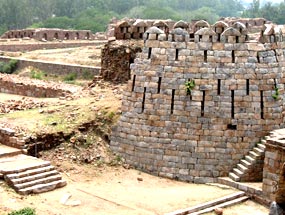Tughlaqabad Fort once housed the capital city of
the Tughlaq dynasty in Delhi. Know about Fort of Tughlaqabad/
Tugluqabad in India.
Tughlaqabad Fort

Location: Qutub-Badarpur Road, Delhi
Founded By: Ghiyas-ud-Din Tughlaq
Founded In: 1321-25
Tughlaqabad fort, which once served as the symbol of the power of
Tughlaq dynasty in Delhi, lies completely in ruins today. It is situated
on the Qutub-Badarpur Road in the city, near Qutub Minar Complex. It
took approximately four years to build this monument, on which
construction work was started in the year 1321. The person to be
credited with the construction of the Tuglaqabad fort is Ghiyas-ud-Din
Tughlaq, the founder of the Tughlaq dynasty. The fort, which once made
up one-third of the capital city of India, stands towering on a rocky
hill.
The main reasons behind the construction of Tughlaqabad fort were to
protect the empire from the incessant threat of Mongol attacks from the
northwestern borders and serve as its capital. The fort stands adorned
with enormous ramparts, fortifications and the colossal stonework. One
look at the fort reminds us of the architectural talent of the Indian
craftsmen of those times. A number of monuments have been built within
the boundaries of the gigantic fort of Tugluqabad.
These include outstanding palaces, impressive mosques as well as
splendid audience halls. The ramparts and bastions of the fort rise to a
height of somewhere between 15 and 30 meters. They have been made out of
huge blocks of stone and are as much as 10 meters thick at certain
points. The city of Tuglaqabad was situated on the eastern outskirts of
the fort. On its southern side, we can see the mausoleum of
Ghiyas-ud-din Tughlaq, built by the ruler himself. The tomb is situated
in a courtyard and has been built as per Indo-Islamic architecture.
Tughlaqabad Fort comes across as octagonal structure, with a border
that is almost 6.5-km long. The fort has been divided into three parts.
The eastern segment, on the Qutub-Badarpur road, is a rectangular area
surrounded by high walls and ramparts. The western side once used to
house a number of palaces. In the southern side of the Tughlaqabad Fort
is a huge reservoir, which is linked with Ghiyas-ud-Din's tomb by a
walkway.
The south eastern-corner of the fort has a mound that reaches the
fortress of Adilabad. There are a number of hose gates near the mound,
which were used for the purpose of controlling water for irrigation
purposes. Apart from the Bijai-Mandal, a tower, Tughlaqabad Fort also
houses the remnants of several halls and a long underground passageway.
Even though the fort in now mostly in ruins, it stands as a testimony to
the lost glory of the Tughlaq dynasty.


